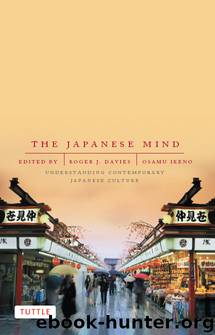The Japanese Mind by Ikeno Osamu Davies Roger

Author:Ikeno, Osamu, Davies, Roger
Language: eng
Format: epub, mobi
ISBN: 978-0-8048-3295-3
Publisher: Tuttle Publishing
Do you think such criticisms are valid and fair? How would you respond to them? Discuss these criticisms in relation to iitoko-dori.
5. Compare scholarly activity and the acquisition of knowledge in Japan with that in other countries of the world.
Ikuji:
CHILDREARING PRACTICES IN JAPAN
Childrearing practices reflect the cultures from which they arise in a kind of reciprocal relationship. Modern Japanese culture is derived from traditional agricultural society, in which people had to cooperate with one another in order to get by, so the main principles of child-rearing focused on creating individuals who knew how to get along with others in the group. Cooperation was emphasized rather than individualism, and because people were protected within the group, self-assertion was considered a form of disobedience. This contrasts markedly with Western culture, especially American culture, which is based on a kind of pioneer spirit in which self-reliance and original thinking are required, resulting in childrearing practices that place much more emphasis on independence, creativity, and self-assertion.
According to Azuma (1994), Japanese parents tend to be of the “seep-down type” as far as discipline in the infant years is concerned. There are two main features of “seep-down” parenting. One is the tendency in Japan for behavior to be “learned by imitation of parents rather than by linguistic analytical explanation,” as is the case in America (ibid., p. 123). In this regard, research reported by Azuma (ibid.) on the childrearing practices of Japanese and American mothers provides insights into differences between the two cultures. Mothers from both countries were asked to learn the task of classifying wooden blocks according to certain shapes and features, and then to teach their four-year-olds how to accomplish this task. Most of the Japanese mothers demonstrated how to build with the blocks first and then had their child imitate them. If the child got it wrong, they repeated the demonstration and let the child try again. In this way, they continued until the child succeeded. On the other hand, American mothers tended to explain systematically the reasons why each block should be placed in a certain position, confirming the child’s understanding one block at a time before allowing the child to attempt the task alone. In other words, Japanese mothers let their expectations “seep down” to their children, while the American mothers were more verbally analytical.
The second feature of “seep-down” parenting is reflected in the fact that “Japanese mothers are not nearly as concerned with parental authority as American mothers” (ibid., p. 125). Azuma found that when children were disobedient, Japanese mothers tended to give in to them, whereas American mothers were more confrontational and placed more emphasis on parental authority. Japanese mothers seemed to change their policies depending on the circumstances in order to avoid creating any mental distance from their children. They also tried to maintain affection suitable for “seep-down” upbringing rather than being consistent in their discipline, which was quite dissimilar to the behavior of the American mothers.
Contrary to popular belief in the West, Japanese parents rarely discipline their
Download
The Japanese Mind by Ikeno Osamu Davies Roger.mobi
This site does not store any files on its server. We only index and link to content provided by other sites. Please contact the content providers to delete copyright contents if any and email us, we'll remove relevant links or contents immediately.
The Brazilian Economy since the Great Financial Crisis of 20072008 by Philip Arestis Carolina Troncoso Baltar & Daniela Magalhães Prates(118015)
International Integration of the Brazilian Economy by Elias C. Grivoyannis(87846)
The Art of Coaching by Elena Aguilar(52873)
Flexible Working by Dale Gemma;(23239)
How to Stop Living Paycheck to Paycheck by Avery Breyer(19616)
The Acquirer's Multiple: How the Billionaire Contrarians of Deep Value Beat the Market by Tobias Carlisle(12207)
Thinking, Fast and Slow by Kahneman Daniel(12015)
The Radium Girls by Kate Moore(11895)
The Art of Thinking Clearly by Rolf Dobelli(10171)
Hit Refresh by Satya Nadella(9012)
The Compound Effect by Darren Hardy(8772)
Tools of Titans by Timothy Ferriss(8180)
Atomic Habits: Tiny Changes, Remarkable Results by James Clear(8154)
Turbulence by E. J. Noyes(7915)
A Court of Wings and Ruin by Sarah J. Maas(7609)
Change Your Questions, Change Your Life by Marilee Adams(7603)
Nudge - Improving Decisions about Health, Wealth, and Happiness by Thaler Sunstein(7524)
How to Be a Bawse: A Guide to Conquering Life by Lilly Singh(7359)
Win Bigly by Scott Adams(7069)
